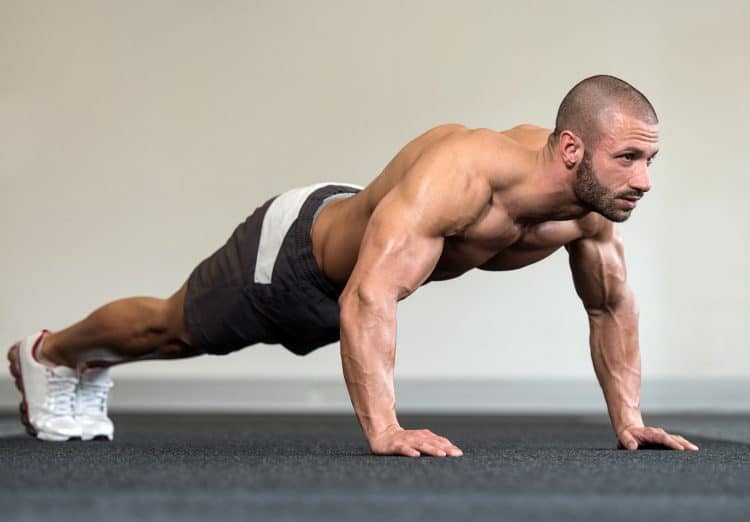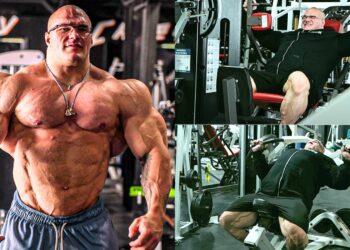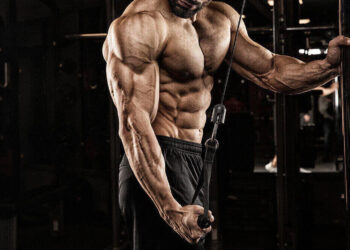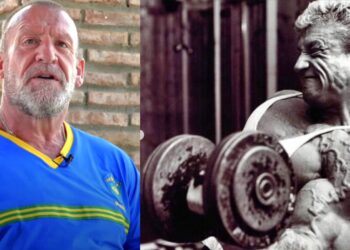Need an idea for a bodyweight triceps builder or maybe something to finish them off after an arm workout? The reverse dip is a sweet option because it’s done from a pushup position which means no equipment or weights needed. The technique modifies the popular chest-building exercise and shifts the emphasis toward the aesthetic three-headed upper arm muscles.
Here’s a complete guide to the reverse dip including exercise tips, benefits, variations, and more.
How To Do The Reverse Dip
Like any resistance-based exercise you have to do it right otherwise you’re wasting your time and will not fully stimulate the target muscle fibers. While a simple movement, we’ve detailed the step-by-step process for proper execution of the reverse dip.
Step 1 – The setup (body and hand position)
- Get on your hands and knees then walk your hands forward until your palms are directly below your lower chest. Your arms should be fully extended and body in a straight line from your shoulders to your butt. Point your fingers straight forward or turn them slightly outward.
Step 2 – Lowering phase and elbow position
- Keep your head neutral and in line with your torso then bend your elbows and lower your chest toward the floor stopping a few inches short. Your elbows should move straight back and not out.
Step 3 – Pushup, mind-muscle connection, and back angle
- Extend your elbows and push yourself back up to the starting position. Really focus on pushing with your triceps muscles and do not use momentum. Mind-muscle connection is very important during the positive or eccentric phase because you don’t want the chest and deltoids to take over.

Pro tip: Be careful not to hyperextend your lower back. If you feel discomfort your back is too arched.
Benefits
Why would someone want to include the reverse dip in their workouts?…
Build your triceps muscles
The first and most obvious benefit of the reverse dip is that it’s a muscle and strength building activity. In fact, it’s essentially a pushup done on your knees and while the focus is triceps it also works the chest and shoulder muscles to.
Level Up Your Fitness: Join our 💪 strong community in Fitness Volt Newsletter. Get daily inspiration, expert-backed workouts, nutrition tips, the latest in strength sports, and the support you need to reach your goals. Subscribe for free!
Improve your pushing strength
If you don’t have a lot of upper body strength, this is a great way to build up your pushing muscles like the triceps, chest and shoulders. This also carries over to your other resistance training movements and if you cannot do a full pushup, then this is a good progression.
Very accessible and good for beginners
You don’t need weights or equipment and because the reverse dip is done from your knees, most people can probably crank out a few reps.
Drawbacks
There is one notable drawback to this exercise and that is, if you’re not careful, you can hyperextend your lower back. Try to keep your torso in line although it’s ok to have a slight arch in your lower back.
Variations and Alternatives
The reverse dip is a great basic triceps exercise if you’re new to developing your upper body strength or need something to pump up your tris. The variations and alternatives listed below are more challenging and consequently more effective.
1- Close grip pushup

A surprising study conducted by researchers and funded by reputable Ace (American Council on Exercise) found that the triangle or close grip pushup activated the triceps better than dips (second best triceps exercise), cable pushdowns, extensions, and the close grip bench press (1).
John Porcari, Ph.D., an exercise physiologist with the University of Wisconsin explained the likely reasoning, “it’s because your body weight is used in the push-ups and dips, and because it’s easier to “cheat” (using momentum to more easily complete reps) while doing the other exercises, specifically the bar push-downs and rope push-downs“.
Level Up Your Fitness: Join our 💪 strong community in Fitness Volt Newsletter. Get daily inspiration, expert-backed workouts, nutrition tips, the latest in strength sports, and the support you need to reach your goals. Subscribe for free!
Close grip pushups also shift a lot of the load onto your triceps muscles, whereas using wider grip would emphasize more of the pecs.
2- Basic pushup

You honestly can’t go wrong with the classic chest pushup. It’s stood the test of time as one of the core bodyweight calisthenics movements used around the world as a measure of upper body pushing strength. Not to mention, there are tons of underrated variations for every experience level.
Related: 42 Best Compound, Isolation, and Bodyweight Chest Exercises
3- Pike pushup
If you’re ready to step it up for an advanced bodyweight triceps builder then aside from a handstand pushup, few options are better than the pike pushup. The idea is to form an inverted V with your body from a pushup position and this shifts a lot of the weight of your body onto your triceps. It’s not easy so you have decent triceps strength.
3- Decline bench/chest press
If you understand the body position of reverse dips, you can see that it’s similar to a decline press that emphasizes the lower sternal chest muscle fibers. Of course, there are many variations of this exercise including the barbell and dumbbell press, as well as the upper body elevated pushup.
4- Triceps dip machine
Dip machines are awesome because they’re more versatile than bodyweight dips. Plus you can make the weight as light or heavy as you want so you don’t need much upper body strength and they’re easier on the wrists than bodyweight dips/pushups. You can replicate the position of reverse dips by leaning slightly forward which will also activate the chest and deltoids.
Program Reverse Dips In Your Workouts
Dips are one of those exercises that can fit well into many different workout routines. For example, as part of an arm workout, after a chest/shoulder focused workout, pull-focused session (back and biceps), or even during leg day. Most people will probably include it in a bodyweight only workout when they cannot make it to a gym or if they prefer to train at home.
There’s no right answer to this because it depends on your goals and how you prefer to structure your training program.
Sets and Reps Range
Reverse dips are a bodyweight exercise which means the weight is fixed and unchangeable. That also means the resistance may be too heavy or not heavy enough. Our recommendation is to perform at least 2-4 sets to within a few reps of muscle failure.
Muscles Worked
- Triceps brachii – As the name implies, the triceps brachii has three heads – lateral, medial and long. Together they straighten the arm (elbow extension), involved in all push based exercises and supporting the bodyweight when you’re holding yourself up.
- Deltoid Anterior – The shoulders are a strong muscle group consisting of three heads just like the triceps. Except if has anterior (frontside of the body), lateral (outer head) and posterior heads. The anterior fibers are involved in anterior arm flexion primarily and it has a few secondary functions.
- Pectoralis major clavicular head – The clavicular head is located exactly where you’d think, below the clavicle bone. The fibers are slanted down at an angle and these muscles medially pull the arms inward. Reverse dips also stimulate the chest muscles although it’s not the primary focus.
- Pectoralis Major Sternal Head – Pulling the arms downward, the sternal fibers are located in the lower chest. The reverse dip emphasizes more of the lower sternal chest fibers than the upper chest.
Bottom Line
A simple and convenient bodyweight challenge to stimulate your triceps, the reverse dip is a viable option for beginners, intermediates, and even more advanced exercisers. Use it as a primary triceps exercise, warmup movement or finisher to burnout your tris after a workout session. But if you also want other options, we recommend the variations and alternative options included in this article.
Use this guide as a resource to program exercise variations in your push focused workouts.
Interested in measuring your progress? Check out our strength standards for Bench Press, Push Ups, Decline Bench Press, and more.








